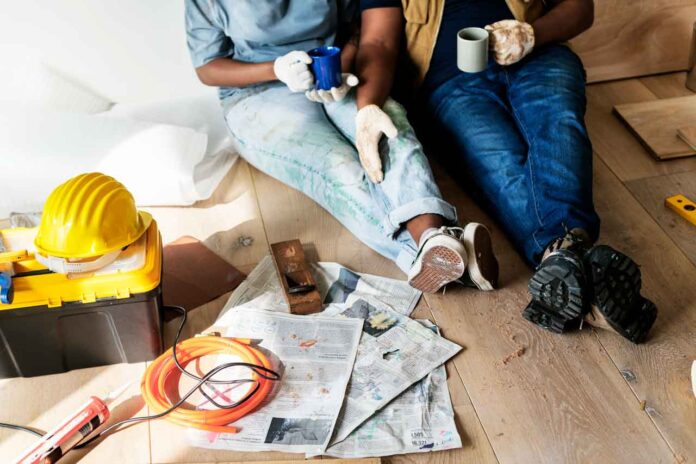THUNDER BAY – LIVING – For homeowners in Ontario, taking on home improvement projects can be exciting and cost-saving. However, it’s essential to understand the legal boundaries for what you can and cannot do yourself when it comes to renovations, plumbing, and electrical work under the Ontario Building Code (OBC).
The OBC sets strict guidelines to ensure safety and quality in all types of construction, and homeowners must adhere to these regulations to avoid fines, unsafe conditions, or the need to redo work that doesn’t meet standards.
Here is a basic overview of what homeowners are allowed to do and when they need to bring in licensed professionals. Check with your local municipality for permits and inspections as needed.
Renovations
In Ontario, homeowners have considerable freedom to carry out non-structural renovations without requiring a permit or hiring a professional. However, there are certain limitations.
What You Can Do:
- Cosmetic Changes: Painting, flooring, replacing kitchen cabinets, or updating fixtures like sinks and faucets fall under cosmetic changes, which do not require permits or inspections.
- Non-Structural Alterations: Homeowners can tackle projects like drywall repairs, replacing doors or windows (as long as they’re the same size), or installing insulation.
What Requires a Permit:
- Structural Changes: If your project involves moving or removing load-bearing walls, reinforcing beams, or any changes to the building’s structure, you’ll need a permit. This includes building new additions, garages, or decks beyond a certain size.
- Windows and Doors (Size Change): Changing the size of windows or doors (e.g., enlarging openings) requires a permit, as it affects the structural integrity of the home.
- Fire Safety and Egress Requirements: Renovations that impact escape routes, like modifying staircases or fire exits, also require permits to ensure compliance with safety regulations.
Plumbing
Plumbing work in Ontario is highly regulated, but there are certain tasks that homeowners can legally do on their own.
What You Can Do:
- Minor Repairs and Replacements: Homeowners are allowed to replace faucets, repair leaks, and change showerheads without the need for a licensed plumber.
- Installing or Replacing Toilets and Sinks: These tasks are generally considered minor and don’t require a professional plumber, as long as the work doesn’t involve moving plumbing lines.
What Requires a Licensed Plumber:
- Major Plumbing Work: Installing or relocating plumbing fixtures (like moving a sink from one part of the room to another) requires a permit and must be done by a licensed plumber. This is because altering plumbing lines can affect water pressure, drainage, and the overall plumbing system in your home.
- Sewage and Drainage Work: Any work involving sewer lines, main drains, or venting systems must be done by a licensed professional. These systems are critical to the safety and function of your home, and improper installations can lead to flooding, backflow, or contamination.
- New Plumbing Installations: If you’re adding a new bathroom, kitchen, or laundry room that involves installing new plumbing, this will require both a permit and a licensed plumber.
Electrical Work
Electrical work in Ontario is strictly controlled due to the dangers involved. Homeowners are permitted to carry out some minor electrical repairs, but most significant tasks must be handled by a licensed electrician and inspected to ensure safety.
What You Can Do:
- Replacing Light Fixtures or Switches: Homeowners are allowed to replace existing light fixtures, switches, and outlets, provided they don’t change the wiring itself. If a simple swap-out is all that’s needed, you’re usually in the clear.
- Installing Ceiling Fans: As long as you’re not altering the electrical wiring, installing or replacing a ceiling fan can typically be done by a homeowner.
What Requires a Licensed Electrician:
- New Circuits or Wiring: Installing new circuits, rewiring part of the home, or adding new outlets requires a licensed electrician. Electrical work that involves changing or adding to the home’s wiring system must comply with the Ontario Electrical Safety Code (OESC) and must be inspected by the Electrical Safety Authority (ESA).
- Electrical Panel Changes: If you need to upgrade or modify your electrical panel, this is work for a professional. An upgraded panel or service change (e.g., from 100 amps to 200 amps) must be done by a licensed electrician and inspected.
- Outdoor Electrical Work: Running new electrical lines outdoors (for example, to power an outdoor light or garden shed) also requires a licensed electrician.
Permits and Inspections
Even if a homeowner is allowed to perform certain tasks, some projects still require permits, particularly those affecting the safety, structural integrity, or systems of the home.
When You Need a Permit:
- Major Renovations: Structural changes, building additions, or changing the use of a space (like converting a basement into a legal living area) require a building permit.
- New Plumbing or Electrical Installations: Adding new plumbing or electrical systems requires a permit and licensed professionals.
- Fire and Safety Concerns: Renovations that affect fire safety features (smoke detectors, fire escapes, etc.) must comply with the OBC and may require permits.
Inspections:
Most permitted work, especially in plumbing and electrical, requires inspection after the job is done to ensure it meets the Ontario Building Code and Electrical Safety Code.
Homeowners should schedule these inspections to avoid potential fines and ensure the work is safe.
Conclusion
Homeowners in Ontario have the freedom to perform many DIY tasks, particularly in the realms of cosmetic renovations and minor repairs. However, for more complex projects involving plumbing, electrical, or structural changes, it’s essential to know when to call in a licensed professional and when permits are needed. Ensuring that your work complies with the Ontario Building Code not only keeps your home safe but also avoids costly fines or the need to redo non-compliant work. If in doubt, always check with your local building authority or the Electrical Safety Authority (ESA) to determine whether a permit or licensed contractor is required.







